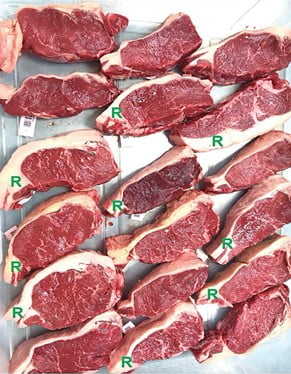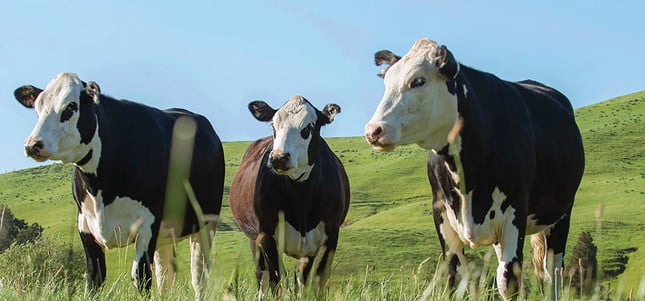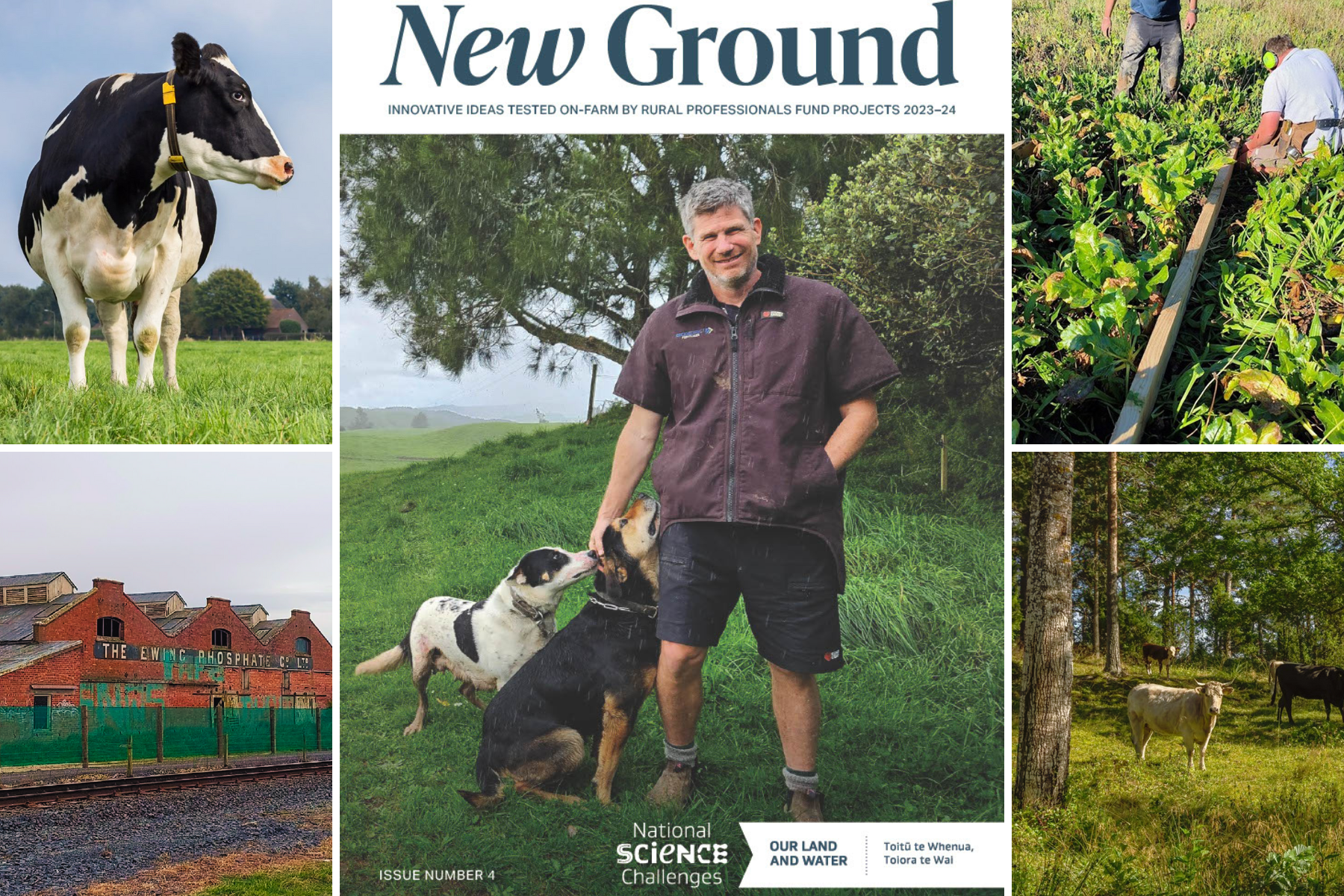We Are What We Eat
If regenerative farming can improve meat quality, particularly intramuscular fat and flavour, this could open up more markets for premium meat products, including from dairy cross cattle.
‘You are what you eat’, the saying goes – and just as it is for people, the same it seems goes for stock.
Increased pasture botanical diversity, longer grazing rounds and higher residuals, along with reduced synthetic fertiliser use, are some of the key practices of regenerative farming.
Regenerative farming can be hard to define as it is outcomes-focused and more about principles than practices. It can also mean different things to different farmers in New Zealand and in different countries. Our pasture-based farm management systems already have more in common with these values than in countries where feedlot farming is common.
Because of this, Beef + Lamb New Zealand is interested in regenerative farming as a potential selling point for our meat overseas and says there is a need to act quickly to take full advantage of it. But they also emphasise any claims must not be ‘greenwashing’ and need to be able to be backed up by science.
Studies from overseas have shown cattle finished on diverse mountain pastures, with nearly 40 different species, have improved meat quality and taste compared to pastures on the flats with few species, says Steve Howarth, agricultural consultant with AgFirst.
Originally off a Hawke’s Bay sheep and beef farm, Steve has a strong interest in farm system management that includes sustainable nutrient management and environmental management. This drew him to look more closely at regenerative agriculture. “Regen is gaining a lot of traction but there has been little research done in New Zealand. We need to be able to show farmers what regen looks like, its pros and cons,” he says.
This saw him join forces with Tracey Bayliss, owner of regenerative meat supplier Grandad's Beef, and scientists from AgResearch for a study on meat quality, with funding from Our Land and Water’s Rural Professionals Fund. Could the difference in pasture on regenerative farms be behind the positive comments around taste that Tracey’s meat products had garnered?
Tracey also had a country upbringing on a beef farm, but like a lot of rural youngsters found country living too slow and says she couldn’t get off the family farm fast enough. As a beautician and salon owner she became interested in the relationship between diet and skin problems, which led to an interest in healthy diets for the animals we eat. Eventually, she returned to the farm, running Friesian-Hereford dairy cross cattle – not as a farmer, but marketing its meat and that of other regenerative farmers as Grandad's Beef.
Investigating premium potential
If there was a marked difference between the meat of regeneratively and conventionally raised dairy cross cattle, and the regeneratively raised cattle had improved meat quality, there may be an opportunity to market a premium meat product.
Dairy cross cattle make up around two-thirds of beef animals in the industry. As they have a big influence on the beef sector, there has been increased interest in recent years in finding ways to produce dairy cross animals that are more valuable for beef, including using easy calving, short gestation, high-growth beef breed sires.
Tracey and Steve’s project covered a lot of different areas to see if anything really stood out in meat quality, and if that could be connected to pastoral biodiversity. From there, more scientifically robust studies could be conducted.
Nine conventional farms were paired by geographical location with nine farms their owners considered to be farmed regeneratively. The paired farms were in the same region – either Bay of Plenty, Waikato or Northland, and generally within 25 km of each other.
One of the cattle on each of these paired farms was also paired by breed, sex and age – nine animal pairs. Most were either Hereford-Friesian crosses or Angus- Friesian crosses.
The animals were sent to slaughter from each farm around late autumn 2021 to two Waikato processing plants. Pastures were assessed around the same time.

Meat testing
A striploin from each of the 18 animals in the nine pairs was sent to AgResearch, aged for two weeks, then frozen. Once all striploins were on hand they were thawed again, with samples taken at the same place on each strip.
A range of tests were performed to assess meat quality including pH, moisture content, elemental analyses, fat-soluble vitamins, intramuscular fatty acid profile and colour. Most tests showed no significant difference between farm types in the levels of fatty acids considered to be beneficial to human health (see Table 1).

Pasture testing
On each of the 18 farms a typical paddock was looked at that had not been used for cropping, hay or silage within the last five years, had less than 15 degrees slope, and was ready for grazing within two days. An additional paddock was selected for a post-grazing assessment.
Herbage mass, botanical composition, herbage mineral content and nutritive value, and soil nutrients were assessed in pastures prior to grazing, and the residual herbage mass of a pasture that had been grazed within two days.
Both farm types had similar amounts of herbage on their pasture before grazing. The amounts left after grazing were also similar. This suggests that while longer rounds and higher residuals may be an aspiration for regenerative farmers, this may be difficult to achieve in practice, says Steve.
There were low numbers of pasture species overall on both farm types – around nine on regenerative farms and eight conventional. Because of this, botanical biodiversity was unlikely to make a difference to meat quality, Steve says. Overseas, regenerative farms may have 40 different species in alpine pastures.
Ryegrass and clover were prevalent on both farm types, but with less ryegrass on regenerative farms. Pasture had three times the amount of legume (clover) on the regenerative farms, which may be related to soil fertility (see Table 2).

conventional farms in the Upper North Island
*P<0.05 and **P<0.01 (statistically significant). NS: Not statistically significant (P>0.05).
Farm management
Each farm was surveyed on livestock and pasture management and included area, number of livestock wintered, pasture renovation/cropping, fertiliser inputs, supplement use and herbicide/pesticide use. The purchase and rearing details of each animal in the trial was looked at along with their health. Grazing and sales details of the wider mob were also looked at.
The regenerative farms were generally smaller, averaging 164 ha, compared to the conventional average of 311 ha. The smaller size likely contributed to the stronger focus on beef on regenerative farms. Winter stocking rates were similar for both, as was average weight gain at 0.6 kg/hd/day.

Around half of each farm group did some form of re-grassing each year with direct drilling preferred. On conventional farms, re-seeding was with ryegrass and clover including plantain and/or chicory or cocksfoot. For the regenerative farms, four used a mix of grasses, legumes and herbs, with up to 20 species sown, while another used similar species to the conventional farms of ryegrass, clover, chicory and plantain.
Herbicides like glyphosate, MCPA and Brushkiller were used by both farm types, with pesticides uncommon for both, and only used for slug control with re-grassing. Anthelmintic products to treat internal parasites were also common for both.
Fertiliser differences
One of the biggest differences between the two farm types was around fertiliser use. Synthetic fertilisers focusing on the macro-nutrients N, P, K, S were widely used on the conventional farms using either DAP or superphosphate.
Synthetic fertilisers weren’t used on the regenerative farms. Both macro- and micro-nutrients were used on the regenerative farmers (including phosphate, potassium, sulphur, boron, zinc, selenium, magnesium, copper and cobalt, plus soil conditioners) from a range of sources, including fish hydrolysate, RPR, lime, potassium sulphate and humates.
Differences in soil fertility may account for less ryegrass and the higher legume content on regenerative farms. Further work is required to find out if differences in legume content affect meat quality, Steve says.
Next steps
Steve emphasises that with the large number of variables considered, this trial was only designed to pick up major differences in meat quality or farming comparisons. It can only be considered a snapshot to show where more research would be useful, he says. This could include:
- The long-term effect of different fertiliser programmes on botanical composition, pasture performance, soil quality, environmental indicators and meat quality
- Studies with larger cattle numbers and tighter control over selection, pairing and management for meat quality comparison
- Testing if legume content is higher all year round on regenerative farms and if this leads to improved meat quality
- Further testing of the meat samples in this study for taste and consumer appeal.
“Knowing where the two farm types don’t differ is just as important as where they do. This gives us an evidence-based approach to start defining, in a New Zealand context, what regenerative agriculture is,” Steve says. “It’s challenging, but something we need to do.”
– Delwyn Dickey for Our Land and Water National Science Challenge
More information:
- Rural Professionals Fund 2020-21
- Download PDF
- All text in this article is licensed for re-use under Creative Commons Attribution 4.0 International (CC BY 4.0)
Author
 View Our Strategy Document 2019 – 2024
View Our Strategy Document 2019 – 2024



